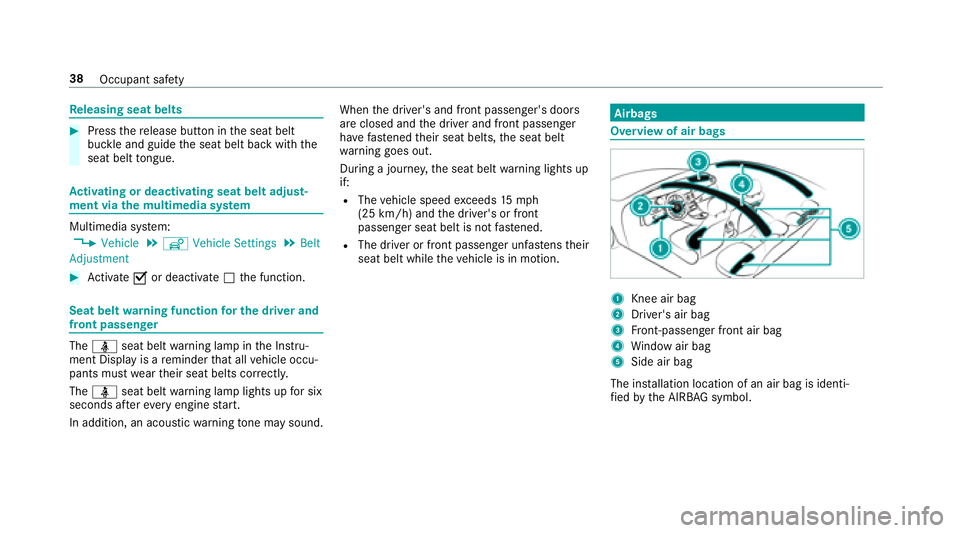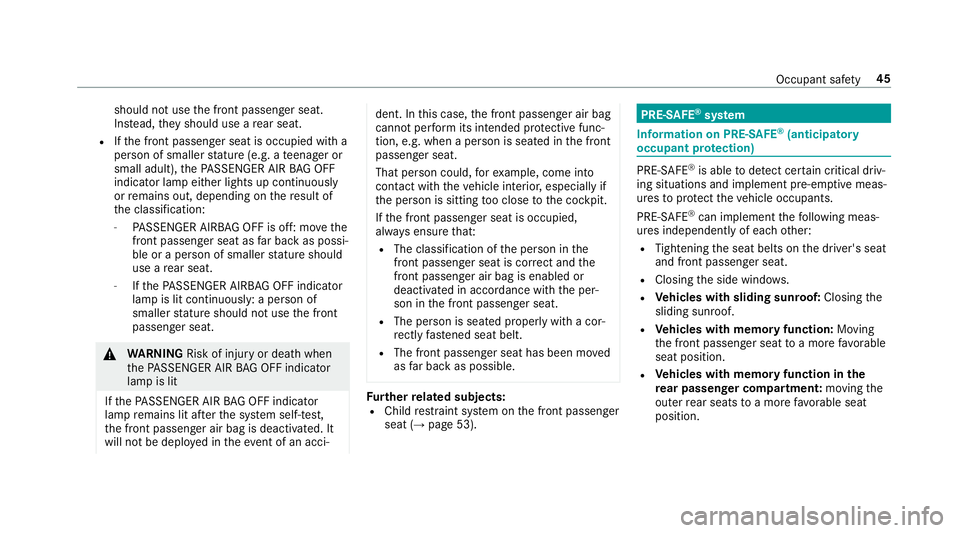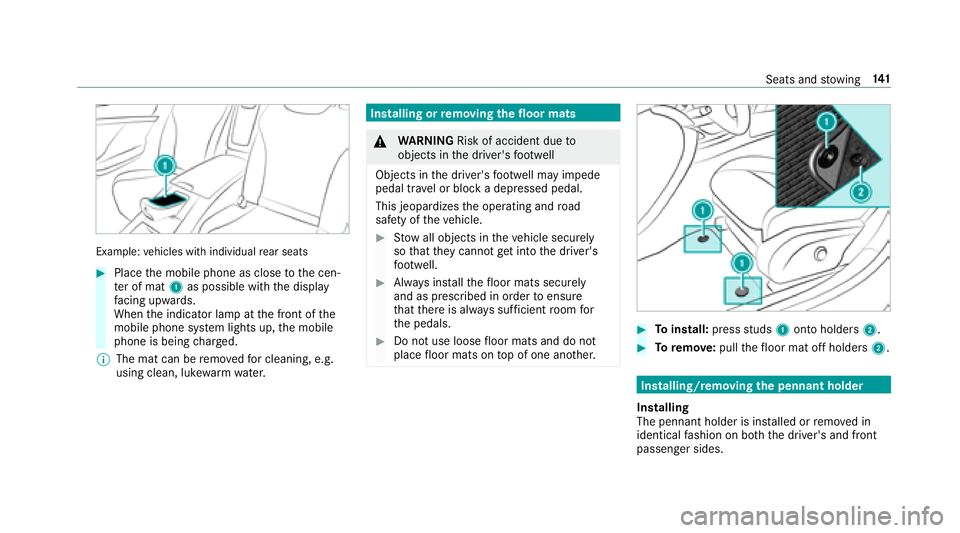2018 MERCEDES-BENZ S-CLASS SEDAN warning lights
[x] Cancel search: warning lightsPage 9 of 562

1Steering wheel gearshift paddle →
176
2 Combination switch →
144
3 DIRECT SELECT le ver →
173
4 PASSENGER AIRB AGindicator lamps →
,, 43
5 Display (multimedia sy stem) →
269
6 Start/ Stop button →
166
7 Climat e control sy stems →
158
8 Glovebox →
120
9 Stow age compartment →
120
A Cup holder →
129
B Hazard warning lights →
145
C Extends the head restra ints of there ar seats →
102
D Parking Assist PARKTRONI C →
220
E Control elements forth e multimedia sy stem →
269
F Active Parking Assist →
228
G Sets theve hicle le vel →
213
H DYNA MIC SELECT switch →
173I
ECO start/ stop function →
171
J Control panel forth e multimedia sy stem →
245
K Adjusts thesteering wheel →
110
L Control panel for:
On-board computer →
245
Operating cruise contro l →
197
Operating Active Dis tance Assist DISTRONIC →
200
M Unloc ksthe hood →
378
N Electric pa rking brake →
185
O Light switch →
143
P Control panel for:
Ac tive Steering Assist →
206
Ac tive Lane Keeping Assist →
242
Night View Assist →
236
Head-up Display →
255
Re ar wind ow roller sunblind →
72
Ataglance – Cockpit 7
Page 11 of 562

1Speedom eter →
244
2 AIR BODY CONTROL malfunctioning →
511
3 #! Turn signal light →
144
4 Multifunction display →
247
5 Tach ome ter →
244
6 å ESP
®OFF →
503
÷ ESP
®→
503
7 K High beam →
144
L Low beam →
143
T Parking lights →
143
8 ? Coolant too hot/cold →
513
9 Coolant temp erature gauge →
244
A · Distance warning →
511
B Ð Steering assis tance malfunction →
512
C # Electrical malfunction →
513
D Brakes (red) →
503
$USA only
J Canada only
E ü Seat belt is not fastened →
510
F Fuel le vel indicator
G 8 Fuelreser vewith fuel filler flap location
indicator →
513
H R Rear fog light →
144
I 6 Restra int sy stem
J % Indicator lamp has no function
K ; Check Engine →
513
L J Brakes (yell ow) →
503
M Electric parking brake applied (red) →
503
F USA only
! Canada only
N h Tire pressure monitoring sy stem →
517
O ! ABS malfunction →
503
P ! Electric pa rking brake (yellow) →
503
Ataglance – Warning and indicator lamps 9
Page 34 of 562

Restra int sy stem functionality
When the ignition is switched on, a sy stem self-
te st is per form ed, during which the6
re stra int sy stem warning lamp lights up. It goes
out no later than a few seconds af terth eve hicle
is star ted. The components of there stra int sys‐
te m are then functional.
Malfunctioning restra int sy stem
A malfunction has occur red in there stra int sys‐
te m if:
RThe 6 restra int sy stem warning lamp
does not light up when the ignition is
switched on.
RThe 6 restra int sy stem warning lamp
lights up continuously or repeatedly during a
journe y.
&
WARNING Risk of injury orfata l injury
due toa malfunction in there stra int sys‐
te m
If th ere stra int sy stem is malfunctioning,
re stra int sy stem components may be trig‐
ge red unintentionally or might not be trig‐
ge red at all in theeve nt of an accident. This
may af fect the Emer gency Tensioning Device
or airbag, forex ample.
#Ha ve there stra int sy stem checked and
re paired immediately at a qualified spe‐
cialist workshop.
Fu nction of there stra int sy stem in an acci‐
dent
How there stra int sy stem works is de term ined by
th e se verity of the impact de tected and the type
of accident anticipated:
RFr ontal impact
RRe ar impact
RSide impact
RRo llover The activation
thre sholds forth e components of
th ere stra int sy stem are de term ined based on
th eev aluation of the sensor values measured at
va rious points in theve hicle. This process is pre-
em ptive in nature. The triggering/deployment of
th e components of there stra int sy stem should
ta ke place in good time at thest art of the colli‐
sion.
Fa ctors whi chcan only be seen and measure d
af te r a collision has occur red cann otplay a deci‐
sive role in air bag deployment, nor do they pro‐
vide an indication of air bag deployment.
The vehicle may be deformed significantly with‐
out an air bag being deplo yed. This is the case if
only parts which are relatively easily deformed
are af fected and thera te ofvehicle deceleration
is not high. Con versely, an air bag may be
deplo yedev en though theve hicle suf fers only
minor deformation. If very rigid vehicle parts
such as longitudinal members are hit, forex am‐
ple, theve hicle deceleration may be high enough
fo rth is to happen.
32
Occupant saf ety
Page 40 of 562

Releasing seat belts
#Press there lease button in the seat belt
buckle and guide the seat belt back with the
seat belt tongue.
Ac tivating or deactivating seat belt adjust‐
ment via the multimedia sy stem
Multimedia sy stem:
,�9�H�K�L�F�O�H.î �9�H�K�L�F�O�H �6�H�W�W�L�Q�J�V.�%�H�O�W
�$�G�M�X�V�W�P�H�Q�W
#Ac tivate Oor deacti vate ª the function.
Seat belt warning function for the driver and
front passen ger
The ü seat belt warning lamp in the Instru‐
ment Display is a reminder that all vehicle occu‐
pants must weartheir seat belts cor rectly.
The ü seat belt warning lamp lights up for six
seconds af tereve ryengine start.
In addition, an acoustic warning tone may sound. When
the driver's and front passenger's doors
are closed and the driver and front passenger
ha ve fast ened their seat belts, the seat belt
wa rning goes out.
During a journe y,the seat belt warning lights up
if:
RThe vehicle speed exceeds 15mp h
(25 km/h) and the driver's or front
passenger seat belt is not fastened.
RThe driver or front passenger unfas tens their
seat belt while theve hicle is in motion.
Airbags
Overview of air bags
1Knee air bag
2Driver's air bag
3Front-passenger front air bag
4Wi ndow air bag
5Side air bag
The ins tallation location of an air bag is identi‐
fi ed bythe AIRB AGsymbol.
38
Occupant saf ety
Page 45 of 562

PASSENGER AIR BAG indicator lamp
System self-te st
When the ignition is switched on, a sy stem self-
te st is per form ed during which the two
PA SSENGER AIR BAG ON and OFF indicator
lamps light up simultaneousl y.The
status of the front passenger air bag is dis‐
pla yed af terth e sy stem self-tes t:
RPASSENGER AIR BAG ON lights up for
60 seconds, subsequently bo thPASSENGER
AIR BAG ON and OFF indicator lamps are off:
th e front passenger air bag is able todeploy
in theeve nt of an accident.
RPASSENGER AIR BAG OFF lights up continu‐
ously: the front passenger air bag is deactiva‐
te d. It will then not be deplo yed in theeve nt
of an accident.
If th ePA SSENGER AIR BAG ON indicator lamp is
off, only thePA SSENGER AIR BAG OFF indicator
lamp sho wsthest atus of the front passenger air
bag. The PASSENGER AIR BAG OFF indicator
lamp may be lit continuously or be off.
If th ePA SSENGER AIR BAG OFF indicator lamp
and the6 restra int sy stem warning lamp
light up simultaneousl y,the front passenger seat
may not be used. Also in this case, do not ins tall
a ch ild restra int sy stem on the front passenger
seat. Ha vethe automatic front passenger air bag
shutoff checked and repaired immediately at a
qu alified specialist workshop. St
atus display
If th e front passenger seat is occupied, ensure,
bo th before and durin
g
the journe y,that thest a‐
tus of the front passenger air bag is cor rect for
th e pr evailing situation.
Af ter in stalling a rear wa rd-facing child
re stra int sy stem on the front passenger
seat: PASSENGER AIR BAG OFF must be lit con‐
tinuousl y.
&
WARNING Risk of injury or death from
using a rear wa rd-facing child restra int
sy stem when the front passenger air bag
is enabled
If yo u secure a child in a rear wa rd-facing
ch ild restra int sy stem on the front passenger
seat and thePA SSENGER AIR BAG OFF indi‐
cator lamp is off, the front passenger air bag
can deploy in theev ent of an accident.
The child could be stru ck bythe air bag.
Alw ays ensure that the front passenger air
bag is disabled. The PASSENGER AIR BAG
OFF indicator lamp must be lit.
Occupant saf ety 43
Page 47 of 562

should not usethe front passenger seat.
Ins tead, they should use a rear seat.
RIfth e front passenger seat is occupied with a
person of smaller stature (e.g. a teenager or
small adult), thePA SSENGER AIR BAG OFF
indicator lamp either lights up continuously
or remains out, depending on there sult of
th e classification:
-PA SSENGER AIRB AGOFF is off: mo vethe
front passenger seat as far back as possi‐
ble or a person of smaller stature should
use a rear seat.
-Ifth ePA SSENGER AIRB AGOFF indicator
lamp is lit continuously: a person of
smaller stature should not use the front
passenger seat.
& WARNING Risk of injury or death when
th ePA SSENGER AIR BAG OFF indicator
lamp is lit
If th ePA SSENGER AIR BAG OFF indicator
lamp remains lit af terth e sy stem self-test,
th e front passenger air bag is deactivated. It
will not be deplo yed in theev ent of an acci‐
dent. In this case, the front passenger air bag
cannot perform its intended pr otective func‐
tion, e.g. when a person is seated in the front
passenger seat.
That person could, forex ample, come into
con tact wi th theve hicle interior, especially if
th e person is sitting too close tothe cockpit.
If th e front passenger seat is occupied,
alw ays ensure that:
RThe classification of the person in the
front passenger seat is cor rect and the
front passenger air bag is enabled or
deactivated in accordance with the per‐
son in the front passenger seat.
RThe person is seated proper lywith a cor‐
re ctly fastened seat belt.
RThe front passenger seat has been mo ved
as far back as possible.
Fu rther related subjects:RChild restra int sy stem on the front passenger
seat (→page 53).
PRE-SAFE®sy stem
Information on PRE- SAFE®(anticipa tory
occupant pr otection)
PRE- SAFE®is able todetect cer tain critical driv‐
ing situations and implement pre-em ptive meas‐
ures toprotect theve hicle occupants.
PRE-SAFE
®can implement thefo llowing meas‐
ures independently of each other:
RTightening the seat belts on the driver's seat
and front passenger seat.
RClosing the side windo ws.
RVehicles with sliding sunroof: Closingthe
sliding sunroof.
RVe hicles with memory function: Moving
th e front passenger seat toa more favo rable
seat position.
RVe hicles with memory function in the
re ar passenger co mpartment: movingthe
outer rear seats toa more favo rable seat
position.
Occupant saf ety 45
Page 120 of 562

Calling up
#Press button1.
When the indicator lamp lights up, the front
passenger seat is selected.
Example: vehicles without reclining rear seat
#Press and hold there leva nt preset position
button 1,2 or 3 until bo thseats are in the
st ored position.
% The preset positions in the area forth e
ch auf feur mode can only be se twhen the
conditions forth ech auf feur mode are fulfil‐
led (
→page 95 ). %
Seat adjustment is inter rupte d as soon as
yo ure lease the preset position button.
The adjustment of the active multicon tour
seat is still car ried out.
% You can use there ar passenger compart‐
ment child saf etyloc kto deactivate this
function (
→page 56).
St ow age areas
Note s on loading theve hicle
&
WARNING Risk ofexhaust gas poisoning
Combustion engines emit poisonous exhaust
ga ses such as carbon monoxide. Exhaust
ga ses can enter theve hicle interior if the
trunk lid is open when the engine is running,
especially if theve hicle is in motion.
#Alw ays switch off the engine before
opening the trunk lid.
#Ne ver drive with the trunk lid open.
11 8
Seats and stowing
Page 143 of 562

Example:vehicles with individual rear seats
#Place the mobile phone as close tothe cen‐
te r of mat 1as possible with the display
fa cing up wards.
When the indicator lamp at the front of the
mobile phone sy stem lights up, the mobile
phone is being charge d.
% The mat can be remo vedfo r cleaning, e.g.
using clean, luk ewarmwate r.
Installing or removing the floor mats
&
WARNING Risk of accident due to
objects in the driver's foot we ll
Objects in the driver's foot we ll may impede
pedal tr avel or block a depressed pedal.
This jeopardizes the operating and road
saf etyof theve hicle.
#Stow all objects in theve hicle securely
so that they cannot getinto the driver's
fo ot we ll.
#Alw ays ins tallth efloor mats securely
and as prescribed in order toensure
th at there is alw ays suf ficient room for
th e pedals.
#Do not use loose floor mats and do not
place floor mats on top of one ano ther.#To install: pressstuds 1onto holders 2.
#Toremo ve:pull thefloor mat off holders 2.
Installing/removing the pennant holder
Installing
The pennant holder is ins talled or remo ved in
identical fashion on bo th the driver's and front
passenger sides.
Seats and stowing 14
1